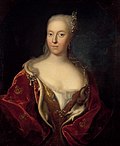Duchess consort of Schleswig (Southern Jutland)
| Picture | Name | Father | Birth | Marriage | Became Duchess | Ceased to be Duchess | Death | Spouse |
|---|---|---|---|---|---|---|---|---|
| Ingeborg Mstislavna of Kiev [3] | Mstislav I, Grand Prince of Kiev (Rurikids) | before 1105 | c. 1117/1118 | c. 1119 elevated to Duchess | 7 January 1131 husband's assassination | ? | Canute Lavard | |
 | Rikissa of Poland | Boleslaw III of Poland (Piast) | c. 12 April 1106/1116 | c. 1127 | c. 1130 husband's accession | 4 June 1134 husband's death | after 1156 | Magnus Nielsen |
 | Sofia of Minsk [1] | Prince Volodar of Minsk (Rurikids)? | c. 1138/1141 | ? | 23 October 1157 husband's accession | 12 May 1182 husband's death | 5 May 1198 | Valdemar I |
 | Margarethe of Bohemia [1] | Ottokar I of Bohemia (Přemysl) | c. 1186 | c. 1205 | 24 May 1212/1213 | Valdemar II | ||
 | Berengária of Portugal [1] | Sancho I of Portugal (Burgundy) | c. 1191/14 December 1194 | c. 1214 | 27 March/1 Abril 1221 | |||
 | Eleanor of Portugal [1] | Afonso II of Portugal (Burgundy) | c. 1211 | 24 June 1229 co-duchess consort alongside Berengária, her stepmother-in-law/aunt | 28 November 1231 husband's death | 13 May 1231 | Valdemar the Young | |
| Picture | Name | Father | Birth | Marriage | Became Duchess | Ceased to be Duchess | Death | Spouse |
|---|---|---|---|---|---|---|---|---|
 | Mechtild of Holstein [1] | Adolf IV, Count of Schauenburg and Holstein (Schauenburg) | c. 1220 or 1225 | 25 April 1237 | 1 November 1250 husband's accession | 29 June 1252 husband's death | c. 1288 | Abel |
 | Margareta of Rügen | Jaromar II, Prince of Rügen (Rügen) | ? | c. 1259/1260 | 27 March 1272 husband's death | c. 1272 | Eric I | |
| Elisabeth of Saxe-Lauenburg | John I, Duke of Saxony (Ascania) | ? | c. 1287 | ? | ? | Valdemar IV | ||
| Adelheid of Holstein-Rendsburg | Henry I, Count of Holstein-Rendsburg (Schauenburg) | ? | c. 1313 | 12 March 1325 husband's death | January 1350 | Eric II | ||
| Picture | Name | Father | Birth | Marriage | Became Duchess | Ceased to be Duchess | Death | Spouse |
|---|---|---|---|---|---|---|---|---|
| Sofia of Mecklenburg-Werle [4] | Nikolaus II of Mecklenburg-Werle-Güstrow (Mecklenburg-Werle) | ? | c. 1315 | c. 1326 husband's became duke | c. 1330 husband's cease to be duke | 6 December 1339 | Gerhard I |
| Picture | Name | Father | Birth | Marriage | Became Duchess | Ceased to be Duchess | Death | Spouse |
|---|---|---|---|---|---|---|---|---|
| Richardis of Schwerin | Günzelin VI, Count of Schwerin-Wittenburg (Hagen) | – | – | 1364 husband's death | before 1386 | Valdemar V | ||
| Kunigunde ? | ? | ? | c. 1370 ? | August 1375 husband's death | c. 1386 | Henry I | ||


















